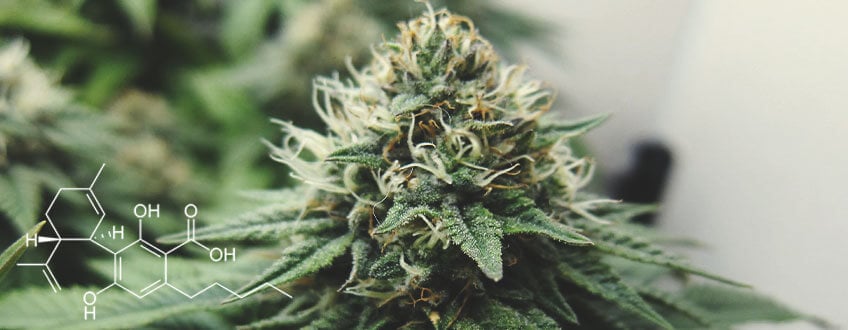.

CBDA: An Emerging Cannabinoid Acid
Science continues to unveil the multifaceted potential of the cannabis plant. CBDA is one of over 100 cannabinoids found in the species, and researchers are putting it through its paces in the lab. What do you need to know about CBDA?
CBDA (cannabidiolic acid) is a cannabinoid acid produced by the cannabis plant. It's one of many cannabis-derived molecules being scientifically investigated for its characteristics and therapeutic potential. The research is quite preliminary, but animal and cell studies have yielded exciting results.
Let's explore CBDA and dive deeper into its therapeutic potential.
WHAT ARE CANNABINOIDS?
Cannabinoids are a class of chemicals that interface with cannabinoid receptors. These receptors appear throughout the human body on many cell types. CB1 receptors are found primarily in the central nervous system, whereas CB2 receptors are predominant in the immune system. These sites make up what is known as the endocannabinoid system (ECS), a regulatory network that helps maintain harmony among other bodily systems.
The human body synthesises its own cannabinoids (known as endocannabinoids). These molecules—anandamide and 2-AG—serve as neurotransmitters within the ECS. Cannabis plants create another class of cannabinoids. Known as phytocannabinoids, many of these chemicals also interface with the ECS to produce distinct effects. They can achieve this because they share a similar molecular structure to endocannabinoids, essentially mimicking their roles within the body.
Scientists have identified over 100 phytocannabinoids so far, many of which display intriguing, albeit inconclusive, medicinal potential. Moreover, cannabinoids don’t interact exclusively with the ECS. In fact, some of them have very low affinity for CB1 and CB2 receptor sites, instead exerting their effects by interfacing with other molecular targets such as serotonin receptors, transient receptor potential channels, the GPR55 receptor, and others.
CBDA: A CANNABINOID ACID
CBDA is one of the most abundant constituents of industrial fibre hemp[1]. Technically speaking, CBDA isn't a cannabinoid—it's a cannabinoid acid. It originates in the cannabis plant as the precursor molecule CBGA (cannabigerolic acid). The enzyme CBDA synthase catalyses a reaction that converts CBGA into CBDA.
Although CBDA is a primary constituent of high-CBD hemp flowers, the process of vaping, smoking, or cooking changes the molecule into the active cannabinoid CBD. Thus, CBDA is a precursor to the non-psychotropic cannabinoid CBD (cannabidiol). Upon exposure to heat, a carboxyl group ejects from the CBDA molecule—a process known as decarboxylation. This results in the conversion of CBDA into CBD. Therefore, CBDA is only available in extracts and other preparations that haven't been exposed to significant heat. Another source of CBDA is the juice of raw cannabis flowers and leaves.
CURRENT RESEARCH ON CBDA
Now that we know a little more about CBDA, let's explore some of the scientific findings surrounding it.
CBDA AND INFLAMMATION
CBDA may help to reduce inflammation related to a host of diseases by blocking enzymes that catalyse the reaction. The cannabinoid acid inhibits COX-2 enzymes, the same proteins targeted by non-steroidal anti-inflammatory drugs (NSAIDs).
Research published in the journal Drug Metabolism And Disposition explored the molecular structure of CBDA[2]. They found that the molecule's carboxylic acid (the part removed during decarboxylation) allows it to block COX-2 enzymes selectively. This trait enables CBDA to carry out a similar action to NSAIDs. Therefore, the cannabinoid acid may help to relieve inflammation and pain.

CBDA REDUCES NAUSEA IN ANIMAL STUDIES
Studies are testing CBD and THC against chemotherapy-induced nausea and vomiting[3], a mechanism that can help to improve the quality of life of cancer patients. CBDA may someday join these cannabinoids to be administered for this purpose.
Research efforts so far include administering CBD to rats and shrews[4] in models of induced nausea.
CBDA and Seizures
Studies have investigated the effects of CBD on seizures[5] for years, with human trials focusing on treatment-resistant forms of epilepsy such as Dravet syndrome and Lennox–Gastaut syndrome. Now, researchers are looking at CBDA for the same purpose. For example, a paper published in the journal Frontiers in Integrative Neuroscience documents the action of CBDA in seizure studies[6], and the implications of its potential to bind to serotonin receptors.
CBDA and Cancer Cell Studies
As one of the leading causes of death across the world, researchers are particularly interested in the effects of cannabinoids on cancer cells. They’ve tested numerous cannabinoids in cellular models of the disease, and a paper published in the journal Toxicology Letters put CBDA up against human breast cancer cell lines[7]. However, this early research offers little in the way of how the cannabinoid acid works in humans.
BRING ON THE CLINICAL TRIALS
As researchers continue to release more data about CBDA, the cannabinoid acid is receiving more attention from mainstream cannabis culture. Early cell studies tell us little about what the future holds for this molecule, but we’re excited to see what clinical trials yield.
- Cannabidiolic‐acid synthase, the chemotype‐determining enzyme in the fiber‐type Cannabis sativa https://febs.onlinelibrary.wiley.com
- Cannabidiolic acid as a selective cyclooxygenase-2 inhibitory component in cannabis. - PubMed - NCBI https://www.ncbi.nlm.nih.gov
- 1805TiPPilot and definitive randomised double-blind placebo-controlled trials evaluating an oral cannabinoid-rich THC/CBD cannabis extract for secondary prevention of chemotherapy-induced nausea and vomiting (CINV) | Annals of Oncology | Oxford Academic https://academic.oup.com
- Cannabidiolic acid prevents vomiting in Suncus murinus and nausea‐induced behaviour in rats by enhancing 5‐HT1A receptor activation https://bpspubs.onlinelibrary.wiley.com
- Long-term cannabidiol treatment in patients with Dravet syndrome: An open-label extension trial. - PubMed - NCBI https://www.ncbi.nlm.nih.gov
- Cannabis Therapeutics and the Future of Neurology https://www.ncbi.nlm.nih.gov
- Cannabidiolic acid, a major cannabinoid in fiber-type cannabis, is an inhibitor of MDA-MB-231 breast cancer cell migration - ScienceDirect https://www.sciencedirect.com







































